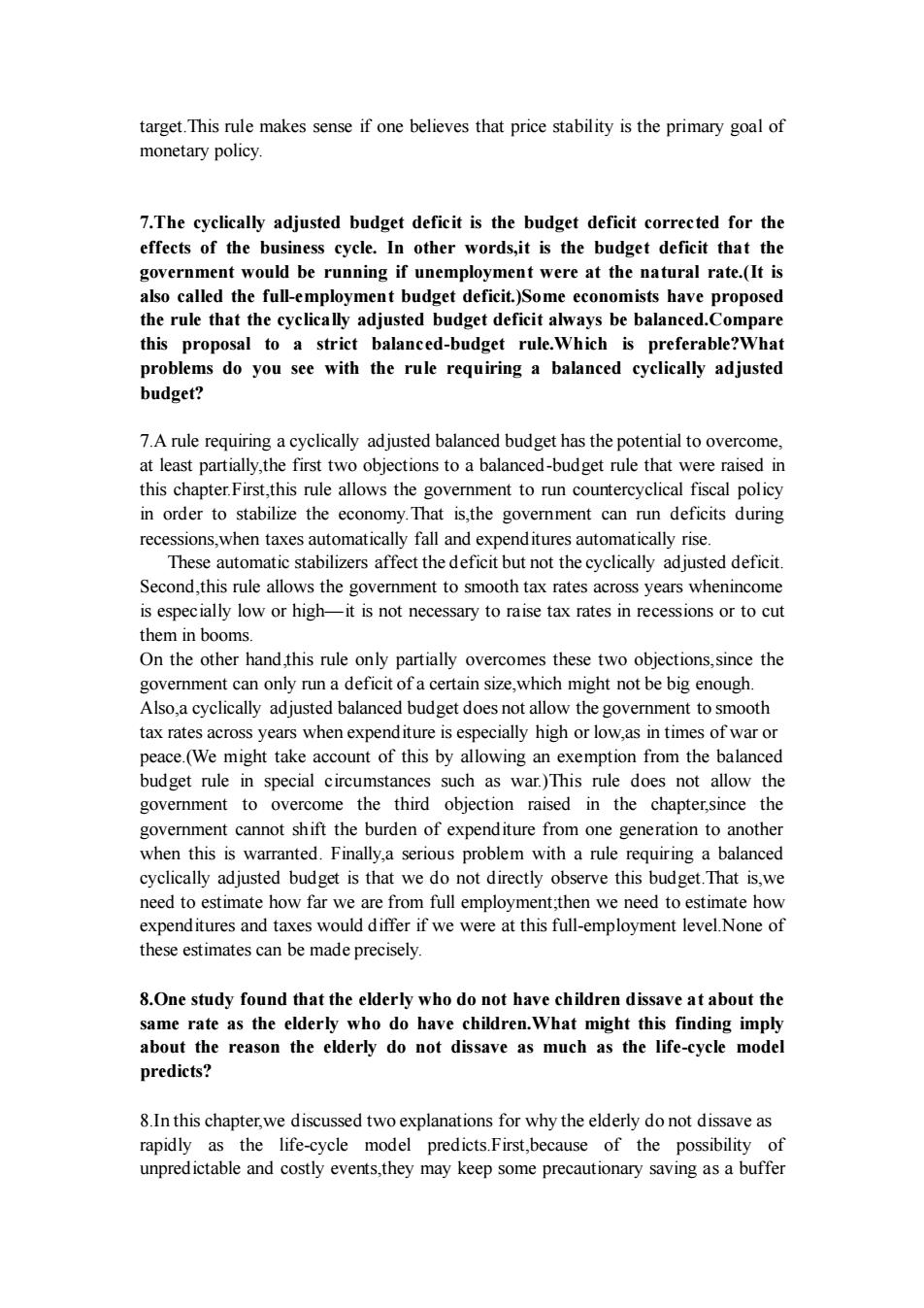正在加载图片...

target.ne believes that price stabilityis the primary goal of monetary policy 7.The cyclically adjusted budget deficit is the budget deficit corrected for the effects of the business cycle.In other words,it is the budget deficit that the would be running if employment were at th natural rate.(It called the ful-employment budget defictomemhaveproposed the rule that the cyclically adjusted budget deficit always be balanced.Compare this proposal to a strict balanced-budget rule.Which is preferable?What problems do you see with the rule requiring a balanced cyclically adjusted budget? 7.A rule requiring a cyclically adjusted balanced budget has the potential toovercome. at least partially,the first two objections to a balanced-budget rule that were raised in this chapter.First,this rule allows the govemment to run countercyclical fiscal policy in order to stabilize the economy.That is the govemment can rn deficits during ons,when taxe s automatica and expenditur es auto ally ris automatic stabilizers affect the deficit but not the cyclically adjusted deficit Second,this rule allows the government to smooth tax rates across years whenincome is especially low or high-it is not necessary to raise tax rates in recessions or to cut them in booms. On the other hand this rule only pa rtially overcom objections,since the government can only run a deficit of a certain size,wh hich might not be big enough Also.a cyclically ad justed balanced budget does not allow the government to smooth tax rates across years when expenditure is especially high or low,as in times of war or peace.(We might take account of this by allowing an exemption from the balanced budget rule special war.)This ule does not allow the government t to overcome the third ralse d in the chapter,sinc the government cannot shift the burden of expenditure from one generation to anothe when this is warranted.Finally,a serious problem with a rule requiring a balanced cyclically adjusted budget is that we do not directly observe this budget.That is.we need to estimate how far we are from full employment then we need to estimate how s and t xes would differ if we were at this full-employme level.None of 8.One study found that the elderly who do not have children dissave at about the same rate as the elderly who do have children.What might this finding imply about the reason the elderly do not dissave as much as the life. -cycle model predicts? 8.In this chapter,we discussed two explanations for why the elderly do not dissave as rapidly as the life-cvcle model predicts First because of the possibility of unpredictable and costly events,they may keep some precautionary saving as a buffertarget.This rule makes sense if one believes that price stability is the primary goal of monetary policy. 7.The cyclically adjusted budget deficit is the budget deficit corrected for the effects of the business cycle. In other words,it is the budget deficit that the government would be running if unemployment were at the natural rate.(It is also called the full-employment budget deficit.)Some economists have proposed the rule that the cyclically adjusted budget deficit always be balanced.Compare this proposal to a strict balanced-budget rule.Which is preferable?What problems do you see with the rule requiring a balanced cyclically adjusted budget? 7.A rule requiring a cyclically adjusted balanced budget has the potential to overcome, at least partially,the first two objections to a balanced-budget rule that were raised in this chapter.First,this rule allows the government to run countercyclical fiscal policy in order to stabilize the economy.That is,the government can run deficits during recessions,when taxes automatically fall and expenditures automatically rise. These automatic stabilizers affect the deficit but not the cyclically adjusted deficit. Second,this rule allows the government to smooth tax rates across years whenincome is especially low or high—it is not necessary to raise tax rates in recessions or to cut them in booms. On the other hand,this rule only partially overcomes these two objections,since the government can only run a deficit of a certain size,which might not be big enough. Also,a cyclically adjusted balanced budget does not allow the government to smooth tax rates across years when expenditure is especially high or low,as in times of war or peace.(We might take account of this by allowing an exemption from the balanced budget rule in special circumstances such as war.)This rule does not allow the government to overcome the third objection raised in the chapter,since the government cannot shift the burden of expenditure from one generation to another when this is warranted. Finally,a serious problem with a rule requiring a balanced cyclically adjusted budget is that we do not directly observe this budget.That is,we need to estimate how far we are from full employment;then we need to estimate how expenditures and taxes would differ if we were at this full-employment level.None of these estimates can be made precisely. 8.One study found that the elderly who do not have children dissave at about the same rate as the elderly who do have children.What might this finding imply about the reason the elderly do not dissave as much as the life-cycle model predicts? 8.In this chapter,we discussed two explanations for why the elderly do not dissave as rapidly as the life-cycle model predicts.First,because of the possibility of unpredictable and costly events,they may keep some precautionary saving as a buffer